2015 NISSAN GT-R warning
[x] Cancel search: warningPage 247 of 358
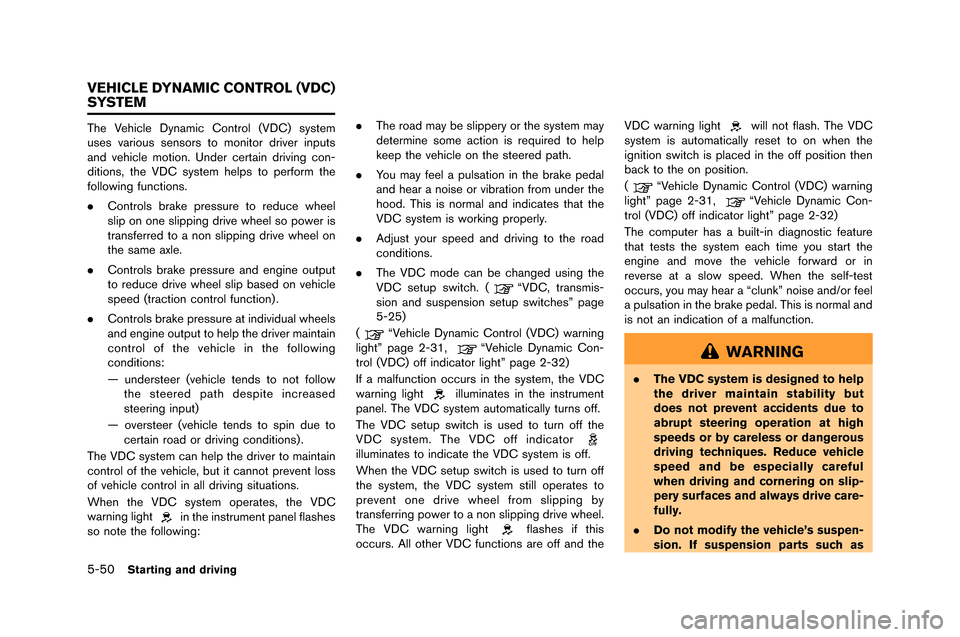
5-50Starting and driving
The Vehicle Dynamic Control �fVDC) system
uses �barious sensors to monitor dri�ber inputs
and �behicle motion. Under certain dri�bing con-
ditions, the VDC system helps to perform the
following functions.
.Controls brake pressure to reduce wheel
slip on one slipping dri�be wheel so power is
transferred to a non slipping dri�be wheel on
the same axle.
. Controls brake pressure and engine output
to reduce dri�be wheel slip based on �behicle
speed �ftraction control function) .
. Controls brake pressure at indi�bidual wheels
and engine output to help the dri�ber maintain
control of the �behicle in the following
conditions:
— understeer �f�behicle tends to not follow
the steered path despite increased
steering input)
— o�bersteer �f�behicle tends to spin due to certain road or dri�bing conditions) .
The VDC system can help the dri�ber to maintain
control of the �behicle, but it cannot pre�bent loss
of �behicle control in all dri�bing situations.
When the VDC system operates, the VDC
warning light
in the instrument panel flashes
so note the following: .
The road may be slippery or the system may
determine some action is required to help
keep the �behicle on the steered path.
. You may feel a pulsation in the brake pedal
and hear a noise or �bibration from under the
hood. This is normal and indicates that the
VDC system is working properly.
. Adjust your speed and dri�bing to the road
conditions.
. The VDC mode can be changed using the
VDC setup switch. �f
“VDC, transmis-
sion and suspension setup switches” page
5-25)
�f
“Vehicle Dynamic Control �fVDC) warning
light” page 2-31,“Vehicle Dynamic Con-
trol �fVDC) off indicator light” page 2-32)
If a malfunction occurs in the system, the VDC
warning light
illuminates in the instrument
panel. The VDC system automatically turns off.
The VDC setup switch is used to turn off the
VDC system. The VDC off indicator
illuminates to indicate the VDC system is off.
When the VDC setup switch is used to turn off
the system, the VDC system still operates to
pre�bent one dri�be wheel from slipping by
transferring power to a non slipping dri�be wheel.
The VDC warning light
flashes if this
occurs. All other VDC functions are off and the VDC warning light
will not flash. The VDC
system is automatically reset to on when the
ignition switch is placed in the off position then
back to the on position.
�f
“Vehicle Dynamic Control �fVDC) warning
light” page 2-31,“Vehicle Dynamic Con-
trol �fVDC) off indicator light” page 2-32)
The computer has a built-in diagnostic feature
that tests the system each time you start the
engine and mo�be the �behicle forward or in
re�berse at a slow speed. When the self-test
occurs, you may hear a “clunk” noise and/or feel
a pulsation in the brake pedal. This is normal and
is not an indication of a malfunction.
WARNING
. The VDC system is designed to help
the driver maintain stability but
does not prevent accidents due to
abrupt steering operation at high
speeds or by careless or dangerous
driving techniques. Reduce vehicle
speed and be especially careful
when driving and cornering on slip-
pery surfaces and always drive care-
fully.
. Do not modify the vehicle’s suspen-
sion. If suspension parts such as
VEHICLE DYNAMIC CONTROL (VDC)
SYSTEM
Page 248 of 358
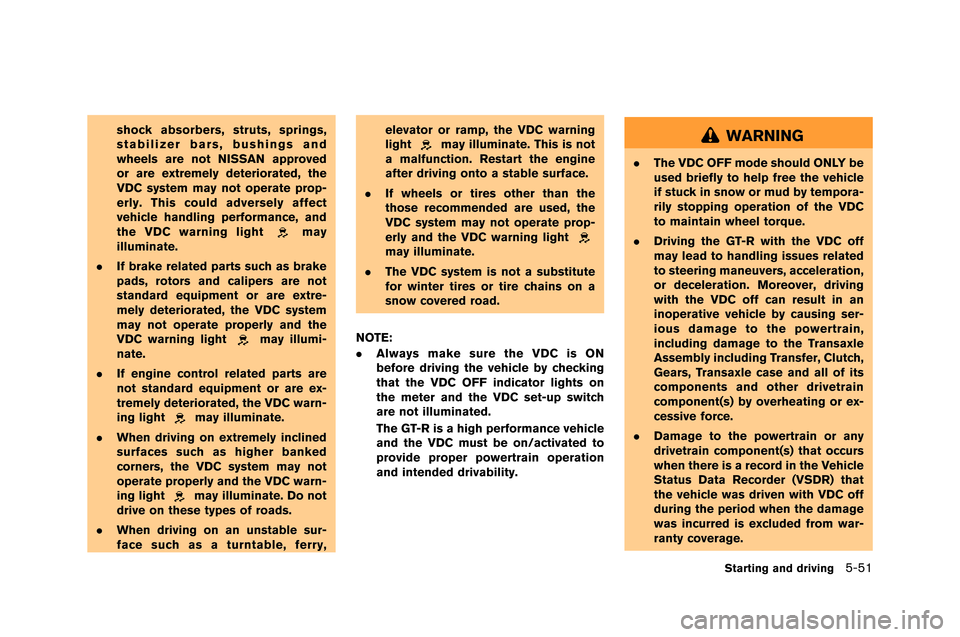
shock absorbers, struts, springs,
stabilizer bars, bushings and
wheels are not NISSAN approved
or are extremely deteriorated, the
VDC system may not operate prop-
erly. This could adversely affect
vehicle handling performance, and
the VDC warning light
may
illuminate.
. If brake related parts such as brake
pads, rotors and calipers are not
standard equipment or are extre-
mely deteriorated, the VDC system
may not operate properly and the
VDC warning light
may illumi-
nate.
. If engine control related parts are
not standard equipment or are ex-
tremely deteriorated, the VDC warn-
ing light
may illuminate.
. When driving on extremely inclined
surfaces such as higher banked
corners, the VDC system may not
operate properly and the VDC warn-
ing light
may illuminate. Do not
drive on these types of roads.
. When driving on an unstable sur-
face such as a turntable, ferry, elevator or ramp, the VDC warning
light
may illuminate. This is not
a malfunction. Restart the engine
after driving onto a stable surface.
. If wheels or tires other than the
those recommended are used, the
VDC system may not operate prop-
erly and the VDC warning light
may illuminate.
. The VDC system is not a substitute
for winter tires or tire chains on a
snow covered road.
NOTE:
. Always make sure the VDC is ON
before driving the vehicle by checking
that the VDC OFF indicator lights on
the meter and the VDC set-up switch
are not illuminated.
The GT-R is a high performance vehicle
and the VDC must be on/activated to
provide proper powertrain operation
and intended drivability.
WARNING
.The VDC OFF mode should ONLY be
used briefly to help free the vehicle
if stuck in snow or mud by tempora-
rily stopping operation of the VDC
to maintain wheel torque.
. Driving the GT-R with the VDC off
may lead to handling issues related
to steering maneuvers, acceleration,
or deceleration. Moreover, driving
with the VDC off can result in an
inoperative vehicle by causing ser-
ious damage to the powertrain,
including damage to the Transaxle
Assembly including Transfer, Clutch,
Gears, Transaxle case and all of its
components and other drivetrain
component(s) by overheating or ex-
cessive force.
. Damage to the powertrain or any
drivetrain component(s) that occurs
when there is a record in the Vehicle
Status Data Recorder (VSDR) that
the vehicle was driven with VDC off
during the period when the damage
was incurred is excluded from war-
ranty coverage.
Starting and driving5-51
Page 249 of 358
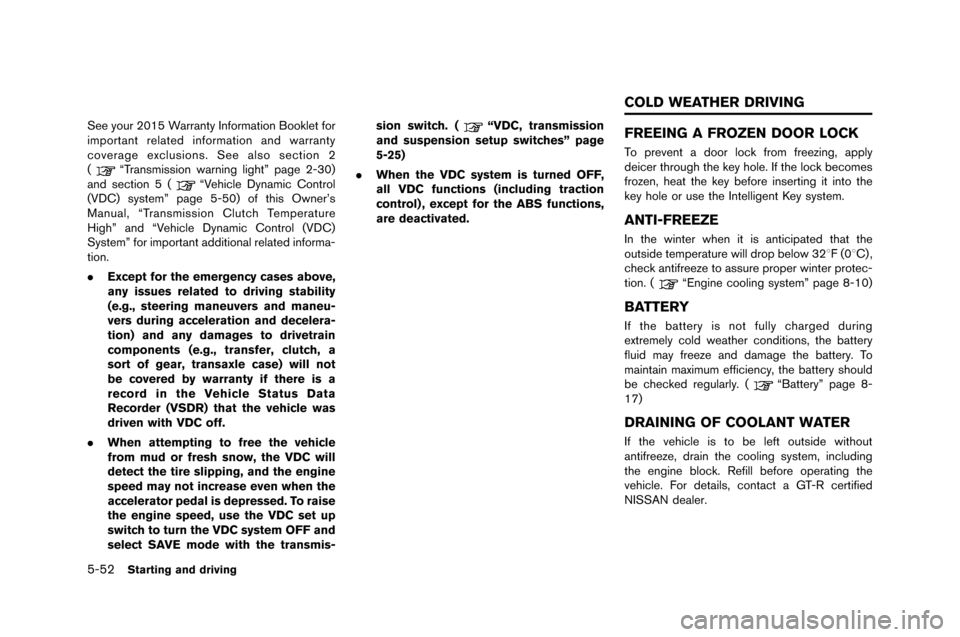
5-52Starting and driving
See your 2015 Warranty Information �fooklet for
important relate�b information an�b warranty
coverage exclusions. See also section 2
(
“Transmission warning light” page 2-30)
an�b section 5 (“Vehicle Dynamic Control
(VDC) system” page 5-50) of this Owner’s
Manual, “Transmission Clutch Temperature
High” an�b “Vehicle Dynamic Control (VDC)
System” for important a�b�bitional relate�b informa-
tion.
. Except for the emergency cases above,
any issues related to driving stability
(e.g., steering maneuvers and maneu-
vers during acceleration and decelera-
tion) and any damages to drivetrain
components (e.g., transfer, clutch, a
sort of gear, transaxle case) will not
be covered by warranty if there is a
record in the Vehicle Status Data
Recorder (VSDR) that the vehicle was
driven with VDC off.
. When attempting to free the vehicle
from mud or fresh snow, the VDC will
detect the tire slipping, and the engine
speed may not increase even when the
accelerator pedal is depressed. To raise
the engine speed, use the VDC set up
switch to turn the VDC system OFF and
select SAVE mode with the transmis- sion switch. (
“VDC, transmission
and suspension setup switches” page
5-25)
. When the VDC system is turned OFF,
all VDC functions (including traction
control) , except for the ABS functions,
are deactivated.FREEING A FROZEN DOOR LOCK
To prevent a �boor lock from freezing, apply
�beicer through the key hole. If the lock becomes
frozen, heat the key before inserting it into the
key hole or use the Intelligent Key system.
ANTI-FREEZE
In the winter when it is anticipate�b that the
outsi�be temperature will �brop below 328F (08C) ,
check antifreeze to assure proper winter protec-
tion. (
“Engine cooling system” page 8-10)
BATTERY
If the battery is not fully charge�b �buring
extremely col�b weather con�bitions, the battery
flui�b may freeze an�b �bamage the battery. To
maintain maximum efficiency, the battery shoul�b
be checke�b regularly. (
“�fattery” page 8-
17)
DRAINING OF COOLANT WATER
If the vehicle is to be left outsi�be without
antifreeze, �brain the cooling system, inclu�bing
the engine block. Refill before operating the
vehicle. For �betails, contact a GT-R certifie�b
NISSAN �bealer.
COLD WEATHER DRIVING
Page 250 of 358

TIRE EQUIPMENT
The GT-R summer tires are made from a
speciall�f formulated rubber to maximize the
�behicle’s performance capabilities. Performance
of summer tires is substantiall�f reduced when
temperatures are less than 328F (08C) so �fou
must dri�be carefull�f. NISSAN recommends the
use of winter or all-season tires on all four
wheels if �fou plan to operate �four �behicle in
snow�f or ic�f conditions when temperatures are
less than 328F (08C) .
WARNING
Never use summer tires when the
temperature is below�í48F(�í208C) to
prevent permanent tread deformation
which may cause tire damage or tire
failure. This may cause a loss of vehicle
control which can result in serious
personal injury or death.
Tire chains ma�f be used. (
“Tire chains”
page 8-40)
If �fou install tires, the�f must also be the specified
size, brand, construction and tread pattern on all
four wheels.
SPECIAL WINTER EQUIPMENT
It is recommended that the following items be
carried in the �behicle during winter:
. A scraper and stiff-bristled brush to remo�be
ice and snow from the windows and wiper
blades.
. A sturd�f, flat board to be placed under the
jack to gi�be it firm support.
. A sho�bel to dig the �behicle out of snowdrifts.
. Extra window washer fluid to refill the
reser�boir tank.
DRIVING ON SNOW OR ICE
WARNING
. Wet ice (328F, 0 8C and freezing rain) ,
very cold snow or ice can be slick
and very hard to drive on. The
vehicle will have much less traction
or “grip” under these conditions. Try
to avoid driving on wet ice until the
road is salted or sanded.
. Whatever the condition, drive with
caution. Accelerate and slow down
with care. If accelerating or down-
shifting too fast, the drive wheels
will lose even more traction. .
Allow more stopping distance under
these conditions. Braking should be
started sooner than on dry pave-
ment.
. Allow greater following distances
on slippery roads.
. Watch for slippery spots (glare ice) .
These may appear on an otherwise
clear road in shaded areas. If a
patch of ice is seen ahead, brake
before reaching it. Try not to brake
while on the ice, and avoid any
sudden steering maneuvers.
. Do not use the cruise control on
slippery roads.
. Snow can trap dangerous exhaust
gases under your vehicle. Keep
snow clear of the exhaust pipe and
from around your vehicle.
NOTE:
When driving on snow, select the SAVE
mode with the setup switch. By selecting
the SAVE mode, the engine output is
controlled appropriately for snow or slip-
pery road surfaces. This enables the vehi-
cle to start or accelerate smoothly.
Starting and driving5-53
Page 251 of 358
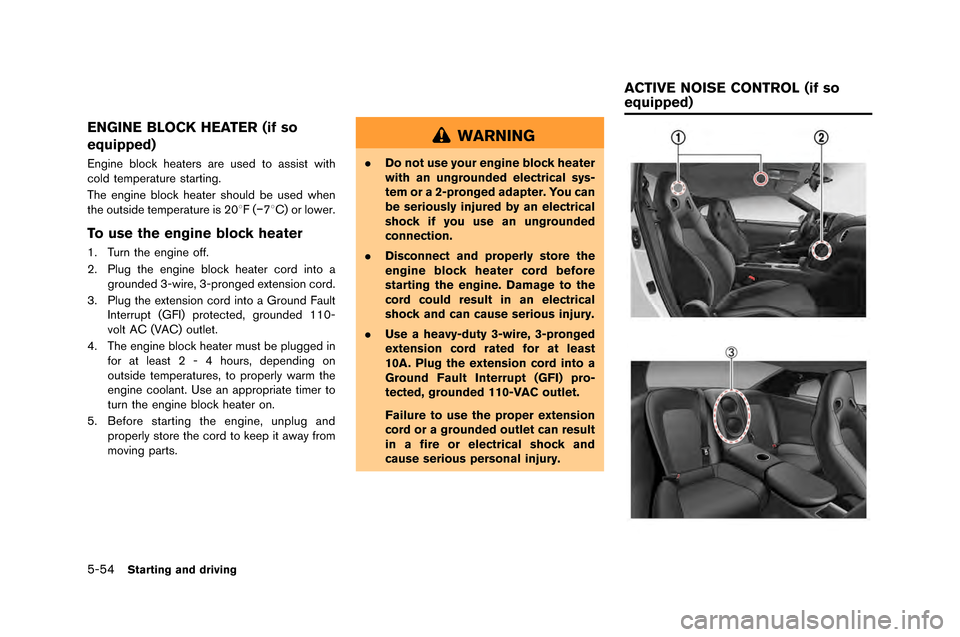
5-54Starting and driving
ENGINE BLOCK HEATER (if so
equipped)
Engine block heaters are use�f to assist with
col�f temperature starting�b
The engine block heater shoul�f be use�f when
the outsi�fe temperature is 208F(�í78C) or lower�b
To use the engine block heater
1�b Turn the engine off�b
2�b Plug the engine block heater cor�f into a
groun�fe�f 3-wire, 3-pronge�f extension cor�f�b
3�b Plug the extension cor�f into a Groun�f Fault Interrupt (GFI) protecte�f, groun�fe�f 110-
volt AC (VAC) outlet�b
4�b The engine block heater must be plugge�f in for at least 2 - 4 hours, �fepen�fing on
outsi�fe temperatures, to properly warm the
engine coolant�b Use an appropriate timer to
turn the engine block heater on�b
5�b Before starting the engine, unplug an�f properly store the cor�f to keep it away from
moving parts�b
WARNING
.Do not use your engine block heater
with an ungrounded electrical sys-
tem or a 2-pronged adapter. You can
be seriously injured by an electrical
shock if you use an ungrounded
connection.
. Disconnect and properly store the
engine block heater cord before
starting the engine. Damage to the
cord could result in an electrical
shock and can cause serious injury.
. Use a heavy-duty 3-wire, 3-pronged
extension cord rated for at least
10A. Plug the extension cord into a
Ground Fault Interrupt (GFI) pro-
tected, grounded 110-VAC outlet.
Failure to use the proper extension
cord or a grounded outlet can result
in a fire or electrical shock and
cause serious personal injury.
ACTIVE NOISE CONTROL (if so
equipped)
Page 254 of 358
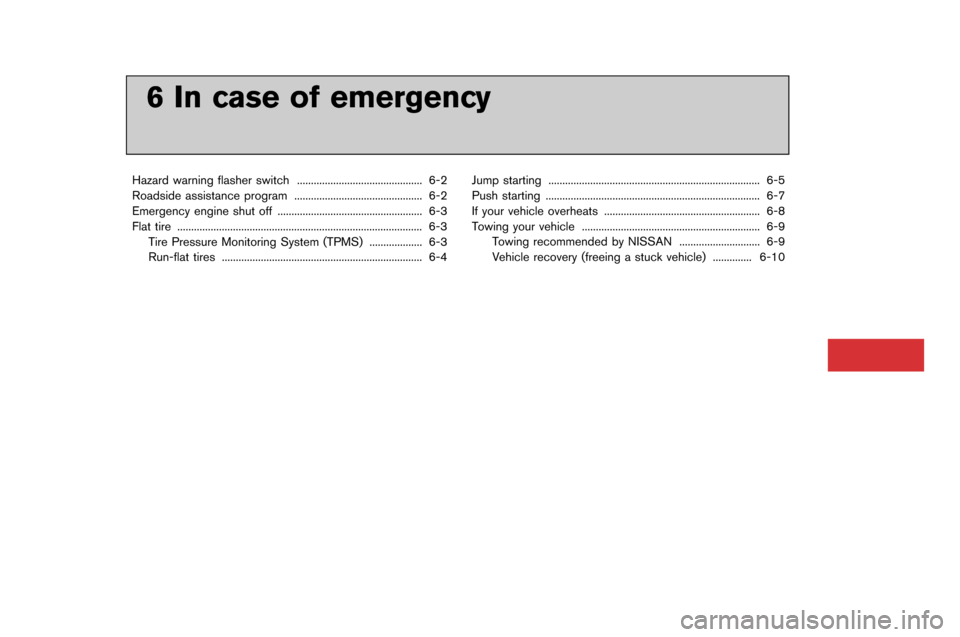
6 In case of emergency
Hazard warning flasher switch..................�-..................�-......... 6-�f
Roadside assistance progra�b ..................�-..................�-.......... 6-�f
E�bergency engine shut off ..................�-..................�-................ 6-3
Flat tire ..................�-..................�-..................�-..................�-................ 6-3 Tire Pressure Monitoring Syste�b (TPMS) ..................�-. 6-3
Run-flat tires ..................�-..................�-..................�-..................�- 6-4 Ju�bp starting ..................�-..................�-..................�-..................�-.... 6-5
Push starting ..................�-..................�-..................�-..................�-..... 6-7
If your vehicle overheats ..................�-..................�-..................�-.. 6-8
Towing your vehicle ..................�-..................�-..................�-.......... 6-9
Towing reco�b�bended by NISSAN ..................�-........... 6-9
Vehicle recovery (freeing a stuck vehicle) .............. 6-10
6 In case of emergency
Hazard warning flasher switch ..................�-..................�-......... 6-�f
Roadside assistance progra�b ..................�-..................�-.......... 6-�f
E�bergency engine shut off ..................�-..................�-................ 6-3
Flat tire ..................�-..................�-..................�-..................�-................ 6-3 Tire Pressure Monitoring Syste�b (TPMS) ..................�-. 6-3
Run-flat tires ..................�-..................�-..................�-..................�- 6-4 Ju�bp starting ..................�-..................�-..................�-..................�-.... 6-5
Push starting ..................�-..................�-..................�-..................�-..... 6-7
If your vehicle overheats ..................�-..................�-..................�-.. 6-8
Towing your vehicle ..................�-..................�-..................�-.......... 6-9
Towing reco�b�bended by NISSAN ..................�-........... 6-9
Vehicle recovery (freeing a stuck vehicle) .............. 6-10
Page 255 of 358
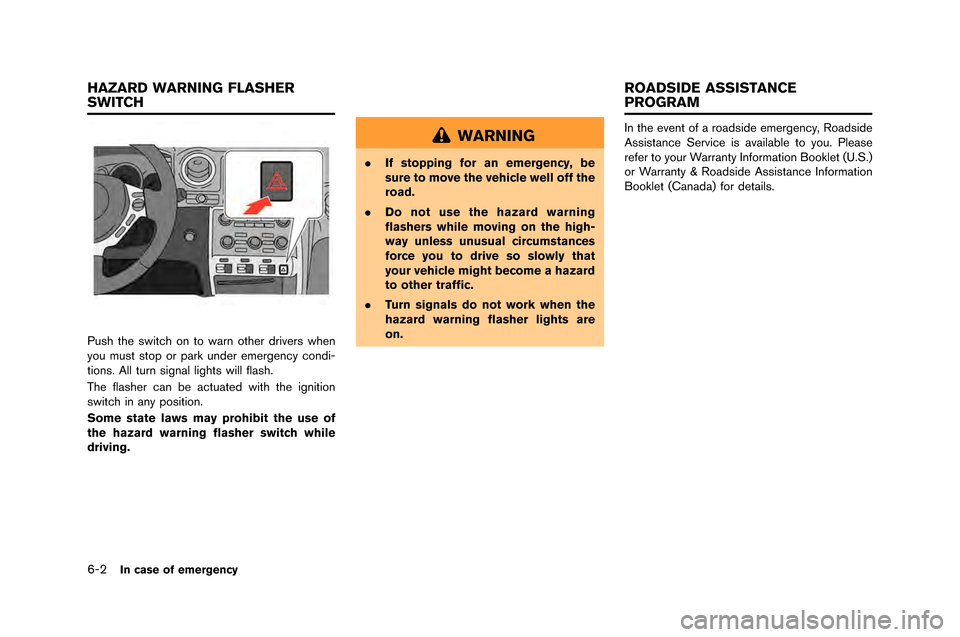
6-2In case of emergency
Push the switch on to warn other drivers when
you \fust stop or park under e\fergency condi-
tions\b All turn signal lights will flash\b
The flasher can be actuated with the ignition
switch in any position\b
Some state laws may prohibit the use of
the hazard warning flasher switch while
driving.
WARNING
.If stopping for an emergency, be
sure to move the vehicle well off the
road.
. Do not use the hazard warning
flashers while moving on the high-
way unless unusual circumstances
force you to drive so slowly that
your vehicle might become a hazard
to other traffic.
. Turn signals do not work when the
hazard warning flasher lights are
on. In the event of a roadside e\fergency, Roadside
Assistance Service is available to you\b Please
refer to your Warranty Infor\fation Booklet (U\bS\b)
or Warranty & Roadside Assistance Infor\fation
Booklet (Canada) for details\b
HAZARD WARNING FLASHER
SWITCH
ROADSIDE ASSISTANCE
PROGRAM
Page 256 of 358
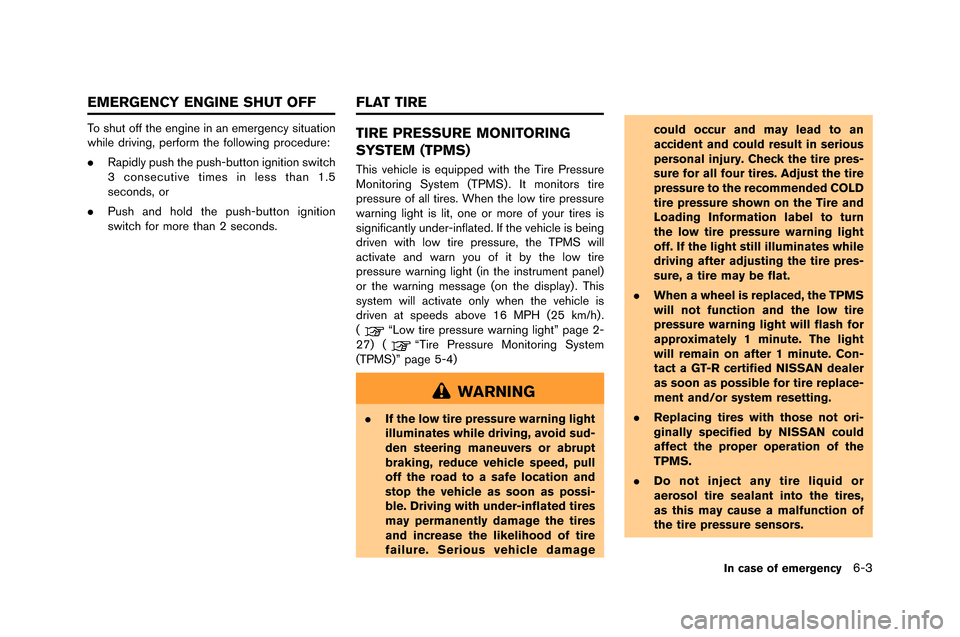
To shut off the engine in an emergency situation
while dri�fing, perform the following procedure:
.�bapidly push the push-button ignition switch
3 consecuti�fe times in less than 1.5
seconds, or
. Push and hold the push-button ignition
switch for more than 2 seconds.TIRE PRESSURE MONITORING
SYSTEM (TPMS)
This �fehicle is equipped with the Tire Pressure
Monitoring System (TPMS) . It monitors tire
pressure of all tires. When the low tire pressure
warning light is lit, one or more of your tires is
significantly under-inflated. If the �fehicle is being
dri�fen with low tire pressure, the TPMS will
acti�fate and warn you of it by the low tire
pressure warning light (in the instrument panel)
or the warning message (on the display) . This
system will acti�fate only when the �fehicle is
dri�fen at speeds abo�fe 16 MPH (25 km/h) .
(
“Low tire pressure warning light” page 2-
27) (“Tire Pressure Monitoring System
(TPMS)” page 5-4)
WARNING
. If the low tire pressure warning light
illuminates while driving, avoid sud-
den steering maneuvers or abrupt
braking, reduce vehicle speed, pull
off the road to a safe location and
stop the vehicle as soon as possi-
ble. Driving with under-inflated tires
may permanently damage the tires
and increase the likelihood of tire
failure. Serious vehicle damage could occur and may lead to an
accident and could result in serious
personal injury. Check the tire pres-
sure for all four tires. Adjust the tire
pressure to the recommended COLD
tire pressure shown on the Tire and
Loading Information label to turn
the low tire pressure warning light
off. If the light still illuminates while
driving after adjusting the tire pres-
sure, a tire may be flat.
. When a wheel is replaced, the TPMS
will not function and the low tire
pressure warning light will flash for
approximately 1 minute. The light
will remain on after 1 minute. Con-
tact a GT-R certified NISSAN dealer
as soon as possible for tire replace-
ment and/or system resetting.
. Replacing tires with those not ori-
ginally specified by NISSAN could
affect the proper operation of the
TPMS.
. Do not inject any tire liquid or
aerosol tire sealant into the tires,
as this may cause a malfunction of
the tire pressure sensors.
In case of emergency6-3
EMERGENCY ENGINE SHUT OFF FLAT TIRE